How Donald Trump won the race to become president
How Donald Trump won the race to become president
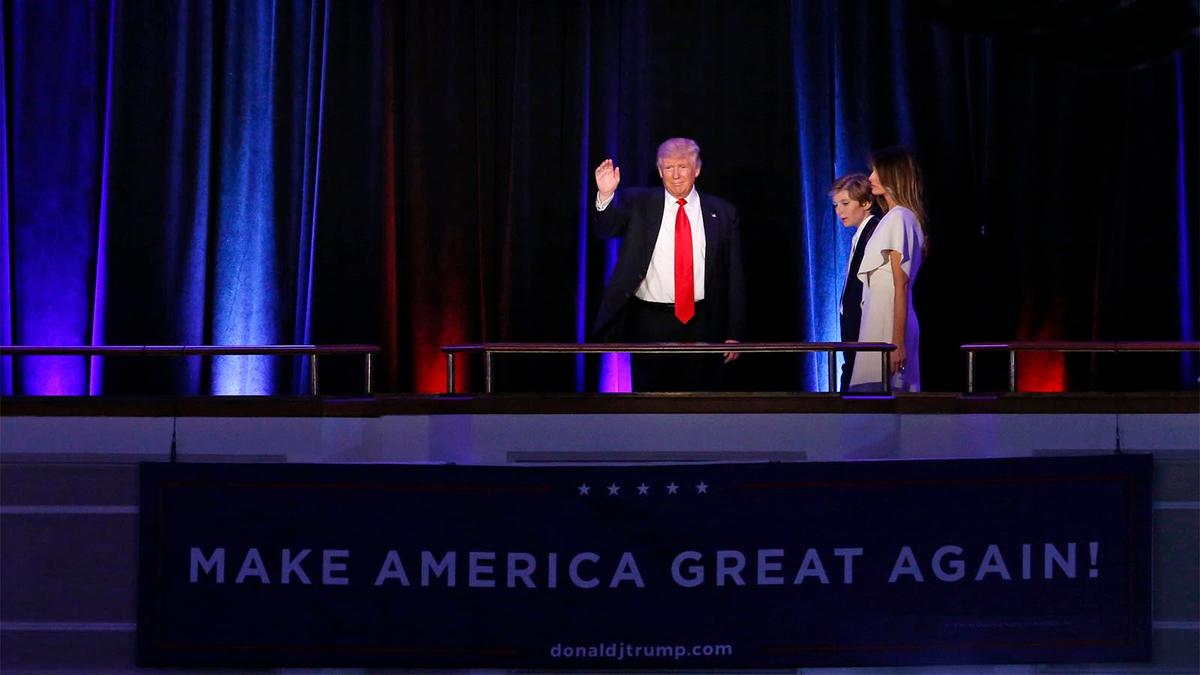
(Brendan McDermid/Reuters)
The rise of Donald Trump
The 10 moments that came to define the most ridiculous, unexpected and divisive political campaign in U.S. history
By Jonathon Gatehouse
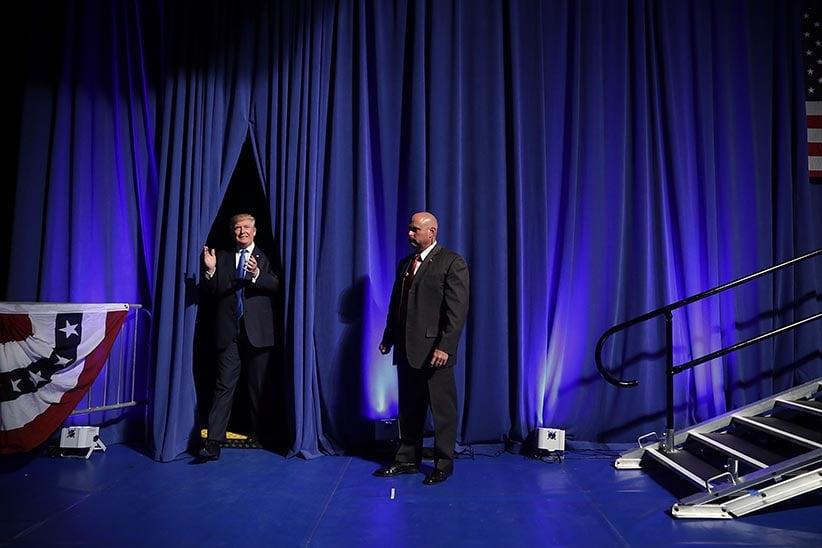
Trump arrives for a campaign rally in the Lackawanna College Student Union on Nov. 7, 2016 in Scranton, Pennsylvania. (Chip Somodevilla/Getty Images)
Donald Trump will be the next president of the United States. A year ago, that might have qualified as the world’s most improbable sentence. Six months ago, it was still too ridiculous to contemplate. And even six days before the American election few truly believed that such a thing was possible. But it happened.
Trump not only took the traditional red states, he won battlegrounds like Florida, Ohio and North Carolina. Then he stormed Democratic strongholds like Pennsylvania and Wisconsin—states that hadn’t voted for a Republican since the first George Bush in 1988. Riding a wave of resentment against the country’s elites, and voter antipathy for the establishment candidate, Hillary Clinton, all the way to the White House.
The polls didn’t predict it and neither did the pundits. The Republican’s own key advisers had been quietly telling reporters that they expected him to lose—badly. Trump himself may have believed that victory was possible, but it wasn’t based on much evidence beyond the turnout at his rallies. In the campaign’s final days he was busy fighting with his pollster over an outstanding $766,000 bill. Clinton was making use of her $100-million fundraising advantage, blanketing the airwaves with her ads, and putting her trust in a ground game that boasted many more volunteers and the technological bells and whistles.
Trumplicans celebrated an improbable victory, gathering at a midtown New York City hotel, wearing red “Make America Great Again” ballcaps, dancing and chanting “call it! call it!” in frustration at the TV networks’ reluctance to give in to the inevitable math and make the win official. While just a few blocks away at the Javitz Convention Center on the banks of the Hudson River, Democrats wept under a glass ceiling. America will elect a female president, someday. But it won’t be Hillary Clinton.
The rest of the world reacted to Trump’s slow-motion win with disbelief at first, then outright horror. The Mexican peso plummeted to a 20-year low. And the prospect of a billionaire businessman becoming president sent stock markets around the globe into a dip, with Dow Jones futures index shedding more than 700 points—a bigger drop than after the 9/11 attacks. Analysts predicted more turmoil to come, while the price of gold surged, as investors looked for shelter from the storm.
Americans have become accustomed to divisive elections—and the partisan guerrilla battles that fill the years between the votes. But now, the country has cleaved in ways that seems far more ominous. Trump’s victory was sealed through the overwhelming support of white, working-class men in rural America and big city exurbs. And it was the result of a campaign that alienated many women, all minorities, and even the traditional power brokers within his own party.
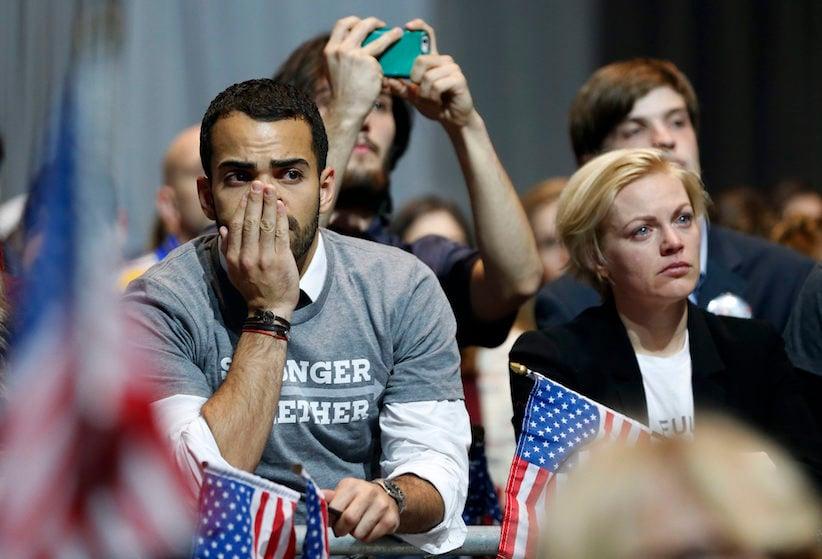
Clinton supporters react as results come in. (Vernon Bryant/The Dallas Morning News via AP)
The 2016 presidential circus was unmatched for its hateful tone, gutter politics and all-out toxicity. Trump’s willingness to wallow where no major party nominee had mucked before—stoking racial fears, promising border walls and religious bans, vowing to jail his opponent, declaring the outcome “rigged” before a single ballot was cast—has surely damaged U.S. democracy. Not to mention the lies. Throughout his 19 months on the trail, he dissembled and distorted, scattering falsehoods, sized small through extra-large. Politifact, the Pulitzer Prize-winning website, fact-checked 337 of the Republican’s claims and found only 14 of them—or four per cent—to be true, while 231—70 per cent—ranged from “mostly false” to “false” to “pants on fire.” (Clinton, the polished politician, was an angel comparatively, with 76 of her 293 claims—26 per cent—falling into the Pinocchio categories.) Yet it all worked.
The Democrats’ choice of Clinton as their standard bearer—opting for familiarity over popularity—ended up playing to Trump’s advantage. Her 25 years on the national stage as a former first lady, U.S. senator and secretary of state, somehow marked her as suspect, rather than qualified. Trump made her controversial use of a private email server while at the State Department the focal point of his attacks, defining her as “Crooked Hillary.” And when the FBI made the oddly timed decision to reopen their investigation into the matter with just 12 days to go in the election, it may well have been the fatal blow for the Democrats. Regardless of the fact that Clinton was cleared of wrongdoing—again—shortly before Election Day.
President-elect Trump will have unfettered hands in Washington, with the Republicans continuing to control both the House and Senate. Whether he will be able, or willing, to follow through on his most extreme promises—the forced deportation of 11.5 million illegal immigrants, banning Muslims from entering the United States, assassinating the families of terrorists, or even simply tearing up international trade deals—is an open question.
The country faces some daunting challenges: the renewed cold war with Russia, the threat of ISIS and the general chaos in the Middle East, global warming, and the perennial problems of race, inequality and gun violence at home. Now it is up to former reality-TV star to try and tackle them.
Four years from now, America may not be great, but it will surely be very different.
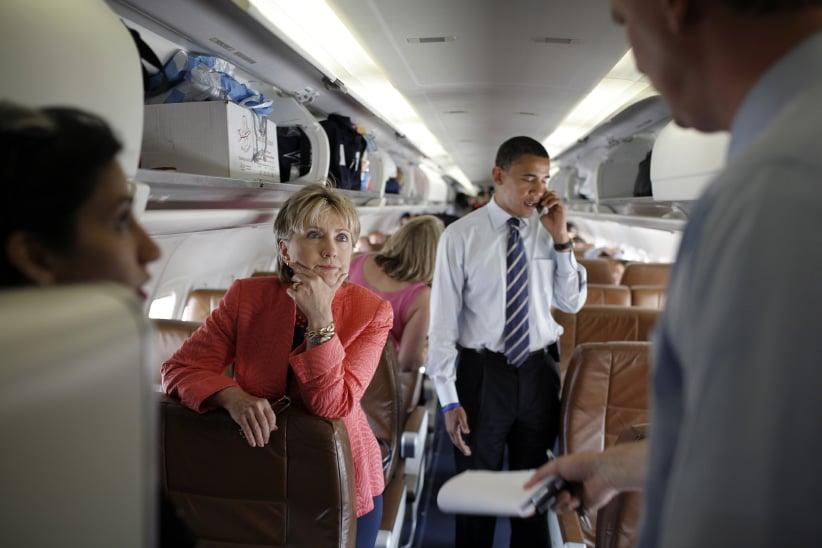
Barack Obama and Hillary Clinton in 2008. (Charles Ommanney/Getty Images)
Chapter 1
Nov. 21, 2008: Clinton’s dream job
The beginning came five months after the end. A trial balloon on the front page of the New York Times, suggesting Hillary Rodham Clinton was set to give up her U.S. Senate seat to become Barack Obama’s secretary of state.
Negotiations had started within days of the president-elect’s landslide victory over John McCain. There was a face-to-face meeting in Chicago, followed by prolonged and persnickety horse-trading in the backrooms. Obama’s team was keen to demonstrate that hope and change started at the top, with a leader who would follow the example of Abraham Lincoln—or at least the bestselling biography of America’s 16th president—and build a Team of Rivals. And Clinton simply wasn’t ready to fade away. “There’s a very small chance that she could run again,” an anonymous “former aide” told the Times. “You’re not going to be the president, so you want to make sure your next few years, which may be your last in public life, really make a mark.”
Clinton, then 60 years old, had been the prohibitive favourite to win the Democratic nomination—better known than any of her competitors, and backed by party and money machines that had twice delivered the presidency to her husband Bill. In January 2007, when she officially launched her White House bid via a brief, “I’m in, and I’m in to win” web video, the polls showed her with 41 per cent support, and Obama a distant second at 17 per cent. But her campaign focused more on her experience and qualifications—crusading lawyer, globetrotting first lady, big deal senator—than why she wanted the job, and frequently failed to connect with voters. Out-organized on the ground in some early contests, then outshone in the debates by the comparatively youthful, 47-year-old Obama, Clinton suffered from what was euphemistically termed an “enthusiasm gap.” By the end, it was more like a chasm.
Her best moment might well have been her most painful: a gracious and emotional concession speech delivered in June 2008, a full four days after her mathematical elimination. She acknowledged the historic step the party was taking in putting forth its first African-American candidate for president, but reminded Democrats that there were other barriers left to overcome. “Let us resolve and work toward achieving very simple propositions: There are no acceptable limits, and there are no acceptable prejudices in the 21st century in our country,” Clinton told the cheering crowd. “You can be so proud that, from now on, it will be unremarkable for a woman to win primary state victories—unremarkable to have a woman in a close race to be our nominee, unremarkable to think that a woman can be the president of the United States. And that is truly remarkable, my friends.”
Clinton spent four years as secretary of state working more to disentangle America from past interests, winding down the wars in Afghanistan and Iraq, than advancing new ones. Then she returned to private life, paid speeches, and a lifelong pattern of denying her designs on the highest office in the land. “I’m not thinking about it,” she told a 2014 gathering of 4,000 auto dealers in New Orleans. “And I’m trying to get other people to not think about it.”
Few, if any, believed her. Donald Trump had been boasting about what a great president he’d make since the mid-1980s, yet in the popular imagination, Clinton was the overly ambitious and entitled one. (A Saturday Night Live skit once featured a fake ultrasound of her in the womb clutching a “Hillary 2008” sign.) Deborah Tannen, a professor of linguistics at Georgetown University, and the author of several bestselling books on gender differences in communication, says the double standard is obvious. News articles talk about Trump’s ambitious plans or business dealings, while Clinton’s political aspirations always come with a modifier like “unbridled,” “ruthless” or even “pathological.” “I think the word ‘ambition’ stands in for a whole network of resentment against women who stand out,” says Tanner. From an early age we’re conditioned to be somehow suspicious about females who want to lead. It’s a mindset that affects women as much as men, says the professor, and one that’s very difficult to overcome. “Misogyny runs deeper than racism, I believe. Gender inequality is in the fabric of everyday life, in every breath and move in our homes.”
Clinton launched her second bid for the Democratic nomination in April 2015, with another web video. It was very different from the first, filled with average men and women talking about their plans for the future: starting a business, moving into a new house, getting married, planting tomatoes, training the dog not to eat garbage. Clinton finally appeared after a minute and half to declare that she was “getting ready to do something too. I’m running for president.” The sell could hardly have been softer.
In her 2008 concession speech, Clinton made reference to American astronaut Karen Nyberg, who had just become the 50th woman to orbit Earth. “If we can blast 50 women into space, we will someday launch a woman into the White House,” she promised. The “highest, hardest glass ceiling” wasn’t shattered, but it was badly cracked, she added. “The light is shining through like never before, filling us all with the hope and the sure knowledge that the path will be a little easier next time.”
Whatever her gifts, prophecy is not among them.
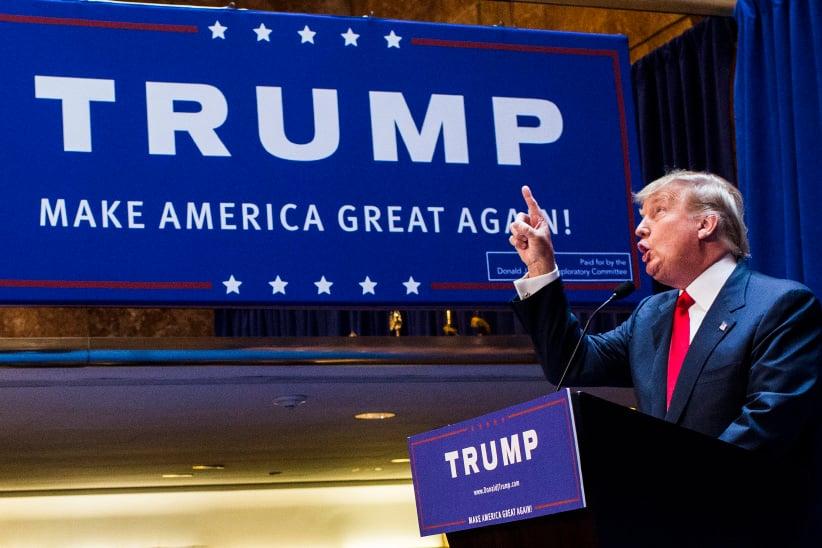
Donald Trump announces his candidacy for the U.S. presidency. (Christopher Gregory/Getty Images)
Chapter 2
July 1, 2015: The entertainment arrives
The statement from Macy’s, announcing its decision to phase out the Donald J. Trump line of menswear, was unusually blunt for corporate speak: “We have no tolerance for discrimination in any form. We welcome customers, and respect for the dignity of all people is a cornerstone of our culture. We are disappointed and distressed by recent remarks about immigrants from Mexico. We do not believe the disparaging characterizations portray an accurate picture of the many Mexicans, Mexican Americans and Latinos who have made so many valuable contributions to the success of our nation.”
Simply put, the largest department store chain in the United States had determined that Trump the politician was bad for business.
It appeared that the buffoonish 70-year-old reality-TV star, famed for his “you’re fired” catchphrase, was finally getting his comeuppance. In the two weeks following the jaw-dropping launch of his campaign for the Republican presidential nomination, his business empire had begun to unravel. Univision, the Spanish-language TV network, cancelled a deal to broadcast his Miss USA and Miss Universe beauty pageants. NBC declared he was no longer the star of The Apprentice. The City of New York was looking at cancelling all of its deals with his organization, including a new golf course in the Bronx. Serta discontinued a Trump-brand mattress (“the state-of-the-art innerspring system follows your personal contours”). And 700,000 people had signed a MoveOn.org petition demanding that Macy’s stop flogging his cheap, made-in-China ties, dress shirts and cufflinks.
Little had gone right with Trump’s June 16, 2015, rally in the gold and marble lobby of his eponymous Fifth Avenue office tower. Someone chose Neil Young’s anti-Republican anthem “Rockin’ In the Free World” as the entrance music for his slow-motion escalator descent to the podium—failing to seek the permission of the irascible songwriter, who was a Bernie Sanders supporter. The cheering audience with the “homemade” placards were later revealed to have been mostly movie extras, paid $50 cash for their morning’s work. Trump threw away the carefully crafted four-page speech that had been handed to reporters in advance, choosing instead to wing it for 45 long and uncomfortable minutes. He declared the American Dream “dead,” while bragging about his own assets and “eight billion, seven hundred thirty-seven million, five hundred and forty thousand” net worth (more than twice the generous estimate Forbes magazine came up with). Trump railed against Obamacare, “Islamic terrorism,” and trade imbalances with China and Japan. And he went on the attack against Mexican immigrants. “When Mexico sends its people, they’re not sending their best,” said Trump. “They’re sending people that have lots of problems, and they’re bringing those problems to us. They’re bringing drugs. They’re bringing crimes. They’re rapists.” Then he announced a plan to build “a great, great wall” along America’s 3,201-km southern border and have the neighbours pay for it.
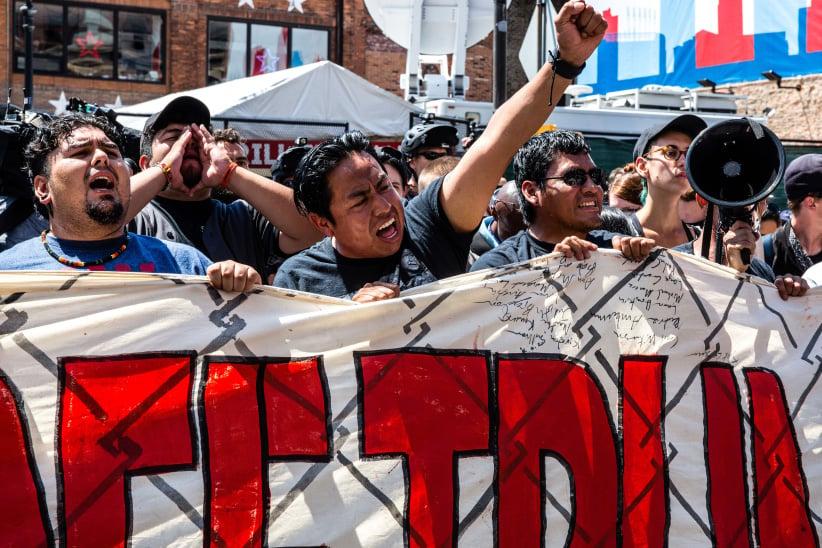
A group of mostly Hispanic-Americans gather to protest a wall on the U.S.-Mexico border. (Timothy Fadek/Redux)
All the while, Trump employees worked the crowd, selling his branded power ties, chocolates, ice cream and a cologne called “Success.”
The world was torn between outrage and mockery. The U.K.’s Guardian newspaper politely called it an “eccentric speech.” Time magazine wrote about Trump’s “empty flair.” The Huffington Post announced that all coverage of his campaign would appear in the Entertainment section of its site. Even NASCAR, a true red state sport, found reason to part ways with the billionaire, cancelling a season-ending awards banquet that was to be held at his Doral National golf course in Miami.
Not that it really mattered. Jeb Bush, the presumed Republican nominee, had declared his White House bid the day before Trump. And the tangerine-hued real estate baron was polling at just three per cent in a crowded 12-candidate Republican field.
Trump has had more flirtations with presidential politics than he has marriages, publicly musing about running in 1988, 2000, 2004 and 2008. He had come very close to launching a campaign in the spring of 2011, when his media crusade to force Obama to release his long-form birth certificate briefly made him the top choice among Republicans. But then the President spent a Saturday night roasting Trump at the White House Correspondent’s Dinner, and a Sunday afternoon supervising the assassination of Osama bin Laden. That evening, an episode of The Celebrity Apprentice was pre-empted for the breaking news coverage.
Trump didn’t abandon the dream. He trademarked his “Make America Great Again” slogan in November 2012. Over the next three years he gave generously to Republican causes and campaigns, and convened regular meetings with a political consultants and strategists. Characteristically, he ignored almost all of their advice. But he did embrace one impractical suggestion: a Mexican border wall that would serve to showcase both his past as a builder and his get-tough-on-everything present.
Almost 80 per cent of Republicans cite immigration as a pressing concern, ranking the influx of foreigners behind only the state of the economy and the threat of terrorism. Trump’s vows to stop crime and bring back jobs by deporting 11 million illegal immigrants—the largest forced migration in human history—played well in the primaries.
But it never made much sense when it came to general election math. America’s Latino population has grown from just under 15 million in 1980, to 57 million in 2015. This November, 27.3 million of them are eligible to vote—12 per cent of total electorate. One of the central lessons from Mitt Romney’s defeat in 2012 was that the Republican Party needed to do better with all minorities and Hispanics in particular. The former Massachusetts governor* took just 20 per cent of the Latino vote, compared to the 40 per cent support George W. Bush enjoyed in 2004. Heading into the final week of the 2016 campaign, Trump was polling at 15 per cent. And he was doing even worse among African Americans, who account for another 12 per cent of the U.S. electorate.
Ana Lamb, the president of LULAC 7250, the Tampa, Fla., chapter of the League of United Latin American Citizens, has spent the past year working against Trump—staging protests at his rallies, registering new voters, helping out at citizenship clinics. Mexican-born, she’s been in the U.S. for 21 years. What she remembers most about Trump’s campaign launch was the feeling of shock. “He doesn’t have any idea who we are,” she says. “Mexicans have been working for him for a long time. He should know better. It’s sad.” Latinos and other immigrant communities have pulled together she says. “We don’t want a president that disrespects us.”
In mid-September, the polling firm Morning Consult crunched all the data from the surveys it had taken over the summer, involving some 50,000 voters. Thirty-eight per cent of those who said they were supporting Hillary Clinton come from visible minority communities. Donald Trump’s vote was 90 per cent white.
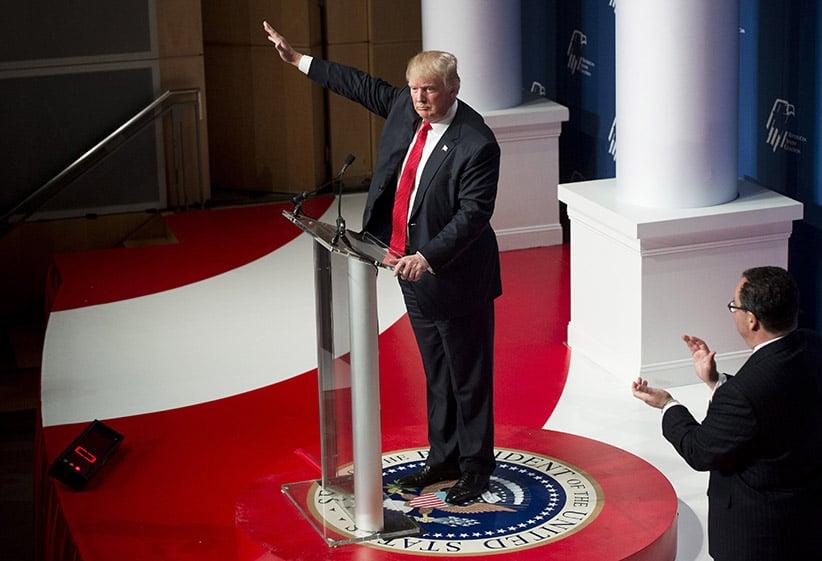
Trump speaks during the 2016 Republican Jewish Coalition Presidential Candidates Forum. (Saul Loeb/AFP/Getty Images)
Chapter 3
Nov. 5, 2015: ‘The new furor’
Donald Trump became the first Republican candidate to receive Secret Service protection because he was the first to demand it.
Back in September at a CNN debate, moderator Jake Tapper had finished the evening by asking the 10 men and one woman on the stage to come up with their own code names. Jeb Bush’s “Eveready,” a battery-inspired refutation of Trump’s claims that he was “low energy,” was the funniest. Rand Paul’s “Justice Never Sleeps” was the weirdest. But the Manhattan billionaire drew some chuckles by answering “Humble.” The actual moniker, “Mogul,” was more in keeping with his self-image. His wife Melania, a former model, became “Muse.”
Two days after gettting his real code name—and almost exactly a year before the election—Trump hosted Saturday Night Live. NBC had ignored an online “dump him” petition with 500,000 signatures, and Hispanic groups protested outside Rockefeller Center. But they were careful to limit the Donald’s on-camera time to just 12 minutes, lest they be forced by election fairness rules to offer equal space to the 13 other candidates still vying for the Republican nomination.
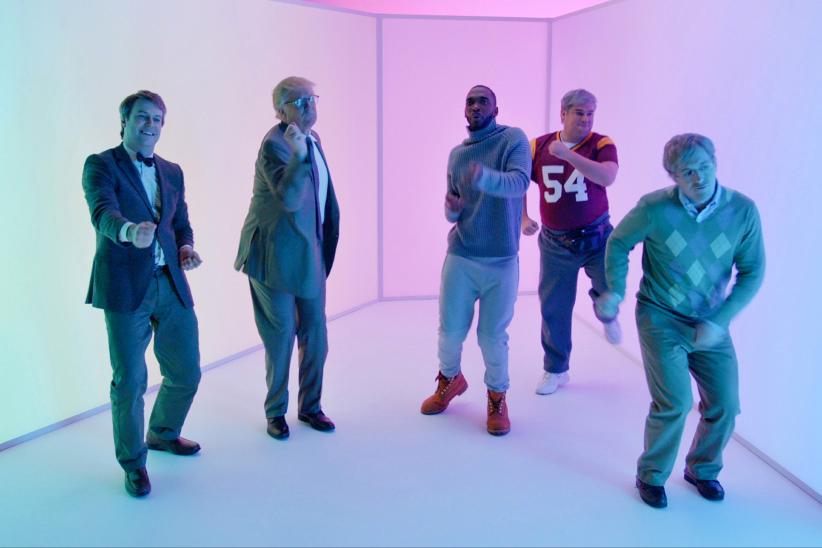
Saturday Night Live’s “Hotline Bling Parody” sketch, featuring Trump. (Dana Edelson/NBC/Getty Images)
There was no question that Trump was the political star of the moment. The first Republican debate, which aired on Fox at the end of the summer, had drawn a record 24 million viewers—the highest ratings ever for a primary gabfest. He was on the cover of magazines like Time, Rolling Stone, and the Hollywood Reporter and out front in all the national polls. The SNL episode, which featured Trump old-man-dancing in a parody of Drake’s “Hotline Bling” video, was hardly a comedy classic, but it delivered the show’s largest audience in two years.
It was the point at which a traditional candidate might have started worrying about appealing to the broader electorate, or acting “presidential.” And there had been some recent signs of a pivot toward reason. During an appearance at an Iowa high school, Trump had told students that he would have “no problem” with appointing a Muslim to his cabinet, or even as his vice-president. “I love the Muslims. I think they’re great people,” he told a TV interviewer that same day.
The Nov. 13 Islamic State-directed attacks in Paris, which left 130 dead, brought an end to that gambit. Trump demanded an immediate halt to the Obama administration’s “insane” plan to accept 10,000 Syrian refugees before the end of 2016. (Canada was on track to resettle 25,000 by February.) He called for the creation of a national database to register Muslims, and police surveillance of mosques. And he made the since thoroughly discredited claim that he witnessed “thousands” of Muslims in New Jersey “cheering” the fall of the Twin Towers on 9/11.
A national CBS opinion survey, taken just prior to the Paris massacres, found that only two per cent of Americans rated terrorism as the most important problem facing the United States. Two weeks later, the figure had risen to 14 per cent, almost tying the economy as the most pressing issue. And the more Trump talked about it, the higher his own poll numbers soared. By the end of November, the businessman had a 20-point advantage over his closest rival, Ben Carson.
An ISIS-inspired workplace shooting in San Bernardino, Calif., on Dec. 2, which left 14 dead and 22 wounded, added fuel to the fire. Barack Obama addressed the nation via television to call for some sort of gun control and beg his countrymen and women to not “turn against one another by letting this fight be defined as a war between America and Islam.” Trump took a different tack. Standing in the hangar deck of a Second World War aircraft carrier on the 74th anniversary of Pearl Harbor, the Republican front-runner called for an all-out ban on Muslims entering the country.
“We have no choice. We have no choice,” he told the cheering crowd. “Our country cannot be the victim of tremendous attacks by people who believe only in jihad.”
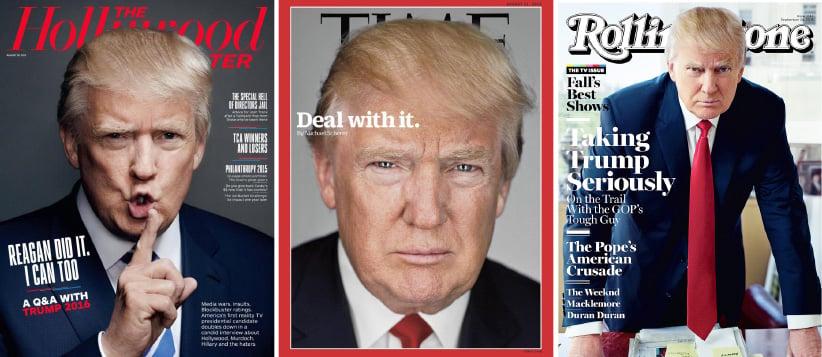
Magazine covers featuring Donald Trump.
The idea of America—a country founded by people fleeing religious persecution—screening entrants by faith didn’t sit well with many. Muhammad Ali, an international icon, issued a statement denouncing the plan. So did basketball great Kareem Abdul-Jabbar. “Trump is ISIS’s greatest triumph, the perfect Manchurian candidate,” he wrote. Jeb Bush, polling at five per cent, called it “unhinged.” New Jersey Gov. Chris Christie, polling two points lower, said it was a “ridiculous position.” Even Marie Le Pen, the leader of France’s ultra-right National Front party, seemed taken aback. “Seriously, have you ever heard me saying something like that?” she asked a television interviewer. The Philadelphia Daily News ran a picture of Trump with his right arm outstretched, sieg heil style, and the headline: “The new furor.” The Huffington Post moved its Trump coverage back into its Politics section.
Fast forward a few weeks to a frigid early January night in Cedar Falls, Iowa, where Trump was warming the crowd with tales of their shared success. “Gravis 41 . . . NBC 38 . . . Fox News, just way out ahead, 35 per cent,” he said, rattling off poll numbers as he brandished yet another issue of Time with his picture on the cover, this time under the headline, “How Trump won.” The billionaire could hardly be bothered to mention the names of the opponents he was wiping the floor with. “People say, ‘Why does he always talk about polls?’ These are people who are No. 9, or 12.”
References to Paris, San Bernardino, ISIS and Muslim threats from Cologne to Jersey City were sprinkled throughout the speech, greeted each time with loud applause and whoops of delight. “I’m just fed up. I’m done with the political correctness crap,” said Janet Nives, a deeply tanned woman who might have been the closest thing in the room to a visible minority. “Everybody is prejudiced. Anyone who says different isn’t telling the truth.”
The primaries had not yet started, but Trump looked unstoppable.
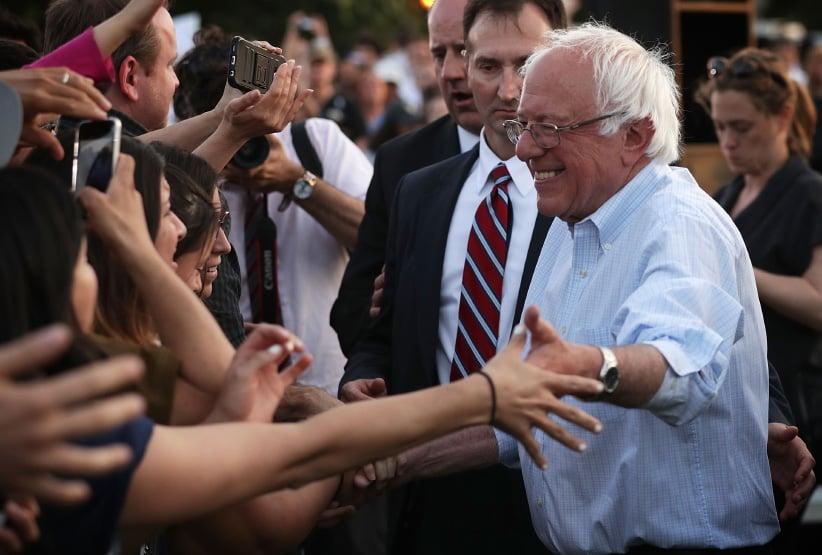
Sen. Bernie Sanders greets supporters during a rally. (Alex Wong/Getty Images)
Chapter 4
Feb. 8, 2016: Clinton feels the Bern
There was no way for Hillary Clinton to put a positive spin on the day’s polls. The Quinnipiac University survey had Bernie Sanders beating every possible Republican presidential challenger by at least four points, while her best showing was a virtual dead heat with Donald Trump. ABC News had asked Democrats which of their candidates was more honest and trustworthy: the overwhelming answer was the fiery senator from Vermont, 48 per cent to Clinton’s 36 per cent. Fox News had Sanders three points ahead nationally, 47 per cent to her 43, giving him his first lead of the primary campaign.
Six months earlier, the former first lady had enjoyed a massive 60-point advantage in the race for the Democratic nomination. By December, her lead had been halved. Now, following her narrowest of victories in the Iowa caucus—by just 0.3 per cent—and Sanders’s slam-dunk, 22-point win in New Hampshire, the momentum had been reversed. Once again, Clinton found herself facing a succession battle instead of a coronation.
In 2008, it had been a youthful junior senator from Illinois who fashioned himself as the agent of change. Now it was a cranky, 73-year-old backwoods socialist. For years, Clinton had been defending herself against Republican charges that she was “too liberal” to be a good president. So she seemed somewhat flummoxed by an attack coming from the other end of the spectrum. “I’m a progressive who gets results and I will be a progressive president who gets results,” she promised a New Hampshire audience. Sanders’s retort was as succinct as it was damaging. “I do not know any progressive who has a super PAC and takes $15 million from Wall Street,” he said.
When Sanders launched his campaign in Burlington, Vt., the previous May, with a rally featuring free Ben & Jerry’s ice cream and a concert by Mango Jam, a local zydeco band, he was polling in single digits nationally. He wasn’t even a member of the Democratic Party, having sat proudly as an independent since he was first elected to the House of Representatives in 1991, and then the Senate in 2006. (The separation wasn’t as large as it appeared: Sanders “caucused” with the Democrats throughout his career, and voted the party line 90 per cent of the time.) But his redistributive platform—a $15 minimum wage and free college tuition, a trillion-dollar jobs and infrastructure program, promises to break up the big banks and introduce Canadian-style government health care—had proven appealing. Especially to young people. In Iowa, Saunders had taken 84 per cent of voters aged 18 to 29. In New Hampshire, it was 83 per cent. The only age demographic Clinton won was 65 and up.
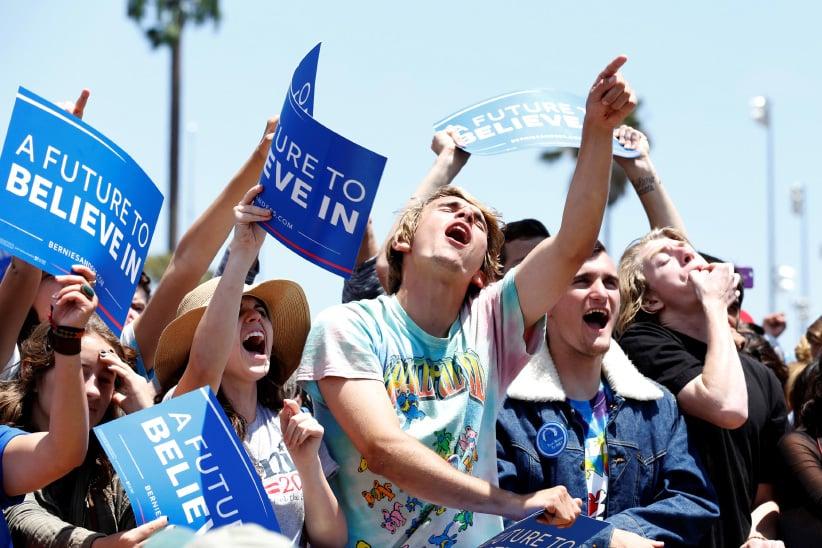
Supporters of Bernie Sanders cheer in Ventura, California. (Jonathan Alcorn/Reuters)
Sanders’s Obamaesque slogan, “A future you can believe in,” was resonating, and the timing was right for his insurgency. The Democratic Party was tilting more and more to the left, with 45 per cent of supporters identifying themselves as “liberal,” up 16 points since 2000. Clinton was more than a familiar face after 25 years on the national stage: she was the Establishment. Sanders pounded her relentlessly on her 2002 vote in favour of the Iraq war. And he had plenty of evidence to back up his claims that she was fighting for Wall Street rather than Main Street. Beginning in 2000, with her successful run for a Senate seat in New York, her campaigns had received $35 million in donations from people working in the finance, real estate and insurance industries. And she and Bill Clinton had collected $26 million in speaking and appearance fees from banks, hedge funds and investment and trade organizations between 2009 and 2014.
Clinton was finding that nothing could be taken for granted in her quest to become America’s first female president, not even the support of women. At an event in New Hampshire, Madeleine Albright, another ex-secretary of state, had made a jokey plea for gender solidarity. “Remember, there’s a special place in hell for women who don’t help each other.” Albright ended up apologizing, but it made little difference. Sanders won New Hampshire’s women by 11 points.
The left wing of the party was ecstatic. The Progressive Democrats of America had openly lobbied Sanders to join the race, staging a petition drive and inviting him to give the keynote address at their 2014 convention. “We thought the country was ready to listen on inequality and Wall Street and taking on climate change,” says Steve Cobble, the group’s Washington-based political director. The feeling was that Clinton would be reluctant to abandon the more centrist strategy that had twice won her husband the White House unless she was pushed. “I don’t think anybody ever thought Bernie would become a rock star with the 19-year-olds,” says Cobble. “But she adjusted, because large chunks of America used him as a lever to say, ‘This is what we want.’”
The strategy was working almost too well. By early April, Clinton’s lead over Sanders in the national polls had shrunk to just one per cent. Almost 55 per cent of voters viewed her unfavourably, and her net score—the difference between those who liked and disliked her—was -14. Only one modern presidential candidate had ever performed more dismally. Donald Trump was sitting at -35.
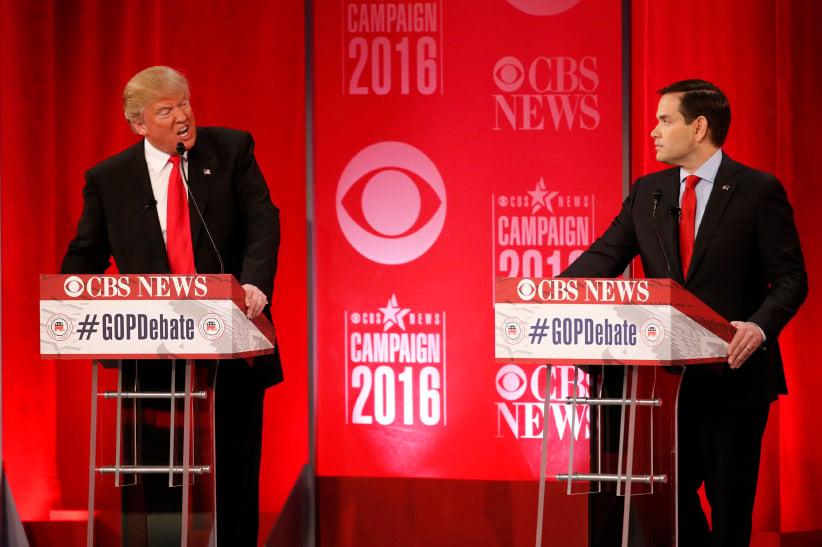
Trump speaks at a Republican candidates debate. Sen. Marco Rubio looks on. (Jonathan Ernst/Reuters)
Chapter 5
March 3, 2016: Can this guy be stopped?
The counterattack came from an unlikely direction. For months, Donald Trump had been acting like the Republican Party’s roastmaster, rather than the leading contender for its presidential nomination. He always preceded Ted Cruz’s name with “Lyin’.” He mocked “low energy” Jeb Bush for calling in his “mommy” to defend him, and compared Dr. Ben Carson to a “child molester.” Marco Rubio was dismissed as a “little lightweight,” Lindsey Graham, a “dumb mouthpiece,” and Rand Paul was simply “truly weird.” Carly Fiorina managed to extract a compliment about her looks in place of an apology after Trump suggested to Rolling Stone that she was too ugly to occupy the Oval Office. But none of his opponents seemed to have the faintest idea of how to take on a politician who ignored the script and was legitimately popular with the public.
So it fell to Mitt Romney to be the one to try and stand up to the bully. Three days after Trump swept Maryland, Delaware, Pennsylvania, Connecticut and Rhode Island on “Super Tuesday,” the man who had led the Republicans to a crushing 2012 defeat volunteered for another losing cause. “Dishonesty is Donald Trump’s hallmark,” he told a crowd at the University of Utah, denouncing the billionaire’s “greed,” “misogyny” and “absurd third-grade theatrics.” The polite and pleasant former governor of Massachusetts drew laughter and applause as he tapped into a hidden reservoir of outrage. “Donald Trump is a phony, a fraud. His promises are as worthless as a degree from Trump University,” he said. And Romney finished with a dark warning about the potential consequences of the politics of rage. “He creates scapegoats of Muslims and Mexican immigrants. He calls for the use of torture. He calls for killing the innocent children and family members of terrorists … This is the very brand of anger that has led other nations into the abyss.”
By this point it was clear that Trump had no intention of running anything like a regular campaign. He was employing a skeleton staff, had opened only a handful of field offices, and had spent just $11.5 million on ads. (Bush, who dropped out of the race after losing to Trump in South Carolina on Jan. 20, had spent $80 million on commercials. Hillary Clinton had spent $38 million by late February.) And he wasn’t courting the media; they were chasing after him.
Trump’s lightning campaign stops in the flyover states were being covered like a papal visit. His every utterance and tweet treated as front-page news. A study prepared by press-monitoring firm mediaQuant in mid-March estimated that the wealthy New Yorker had received $1.9 billion worth of coverage in major print and TV outlets since declaring his candidacy in the summer of 2015—all for free. The Presidential Campaign Tracker, run by the LexisNexis database, found that Trump was the focus of 93 per cent of all stories on the Republican race in the month of February.
“The media’s pumping him up,” Rubio complained—in an appearance on the CBS Morning News. “The media created this Trump phenomenon and then they don’t hold Trump accountable,” Cruz carped on NBC’s Meet the Press.
It was surely an unequal relationship; one that Trump was willing to exploit in every possible manner. At the end of January, he had boycotted a Fox News candidates debate in Iowa, ostensibly because moderator Megyn Kelly had been “unfair” to him in the past. But he let it be known that he was willing to overlook the slights if the network paid him $5 million to attend—a sum he promised to give to veterans’ causes. “Why do I have to make Fox rich?” he asked, referencing the premium ad rates broadcasters were receiving for the highly rated Republican events—all due to his star power. The ransom was never paid and the thesis wasn’t borne out: the Trumpless debate drew 11.5 million viewers, while his own counterprogrammed charity event, carried live on CNN and MSNBC, captured just three million. Yet the stunt was a grand success in terms of free publicity, as Trump’s feud with Fox dominated headlines for the better part of a week.
Ralph Begleiter, the founding director of the Center for Political Communication at the University of Delaware, says he was shocked by the superficial coverage of Trump’s campaign, especially in the early months. “I think the media bears quite a bit of responsibility, because most of us treated Trump as a joke, something that would blow over in a couple of months,” says Begleiter, a longtime world affairs correspondent for CNN. “We spent very little time finding out what he would do in the Oval office.”
To be fair, there was a segment of the U.S. media that was producing critical stories about Trump, but few—in the Republican Party at least—seemed to be paying attention. BuzzFeed did a deep dive into Howard Stern’s archives, digging up the many raunchy interviews Trump had given to the radio shock-jock, and posting clips where the billionaire discussed oral sex, criticized Carmen Electra’s “light post” boob job, and boasted about how he could have “nailed” Princess Di. The Washington Post began investigating Trump’s charitable foundation and established that $102 million he claimed to have given away over the five previous years was all other people’s money. And Esquire republished a 1991 interview where Trump shared his life philosophy: “It doesn’t really matter what [the media] write as long as you have a young and beautiful piece of ass.”
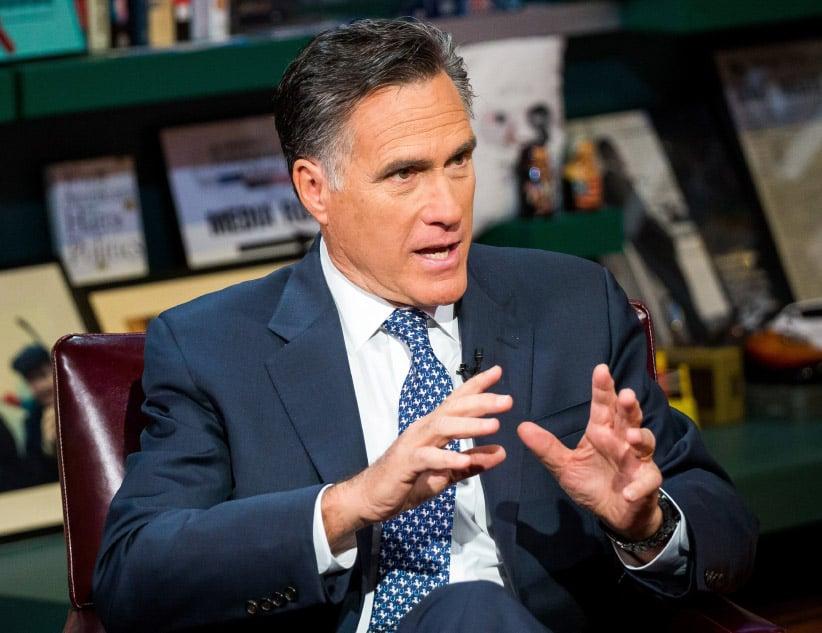
Mitt Romney speaks during a television interview. (Michael Nagle/Bloomberg/Getty Images)
Over his months on the hustings and debate stages, Trump had made many promises—creating jobs, curbing crime, defeating ISIS, renegotiating trade deals—but provided no specifics beyond his pledge to “Make America Great Again.” His opponents sometimes pointed that out, but couldn’t make it stick like his insults. In the hours after Romney’s speech, Trump took to Twitter to label the party elder as a “loser,” “choke artist” and “disaster candidate.” Perhaps most devastatingly, he asked a simple question: “Why did Mitt Romney BEG me for my endorsement four years ago?”
There was a lot of talk about a revolt; a mass movement of big donors and party brass to back a slightly less deplorable alternative like Ted Cruz. Or maybe a contested convention in the summer, where procedural tactics could be used to deny Trump the nomination and replace him with someone sensible. But the burst of courage didn’t last. “Never Trump” never was.
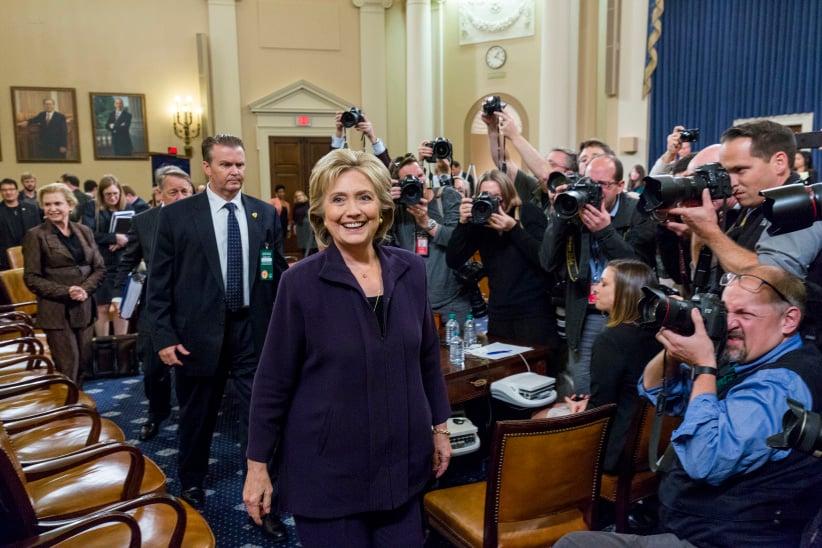
Clinton leaves the room after testifying before the House Select Committee on Benghazi. (Brooks Kraft LLC/Corbis/Getty Images)
Chapter 6
July 5, 2016: Clinton’s lucky break
America celebrated its freedom on the fourth of July: Hillary Clinton, hers, one day later. James Comey, the director of the Federal Bureau of Investigation, stood behind a podium at the force’s Washington headquarters and delivered a lecture instead of charges. A year-long investigation into the Democratic front-runner’s handling of government secrets while she was secretary of state had determined that she was “extremely careless” in her use of a private email server, but something short of a criminal.
“We did not find clear evidence that secretary Clinton or her colleagues intended to violate the laws governing the handling of classified information,” said Comey, a former prosecutor who had probed Whitewater in the mid-1990s and Bill Clinton’s pardon of Marc Rich in 2002. Although Clinton “should have known” that a home server was not the place to be storing and exchanging sensitive information, he said “no reasonable prosecutor” would turn it into a federal case.
The backhanded exoneration removed the last hurdle between Clinton and her party’s presidential nomination. It was hard to say who was more disappointed—Republicans who had been hoping for a drawn-out scandal to drag down her campaign, or Bernie Sanders. The 73-year-old senator had refused to concede the Democratic race even after Clinton took seven of the final nine primaries in June and assured herself a commanding majority of convention delegates. But on July 12, he finally took the stage with Clinton at a rally in New Hampshire and pledged his support. “I intend to do everything I can to make certain she will be the next president of the United States.”
The price for his endorsement was a direct hand in shaping her election platform, which now included favoured Bernie pledges like free college tuition, an end to the death penalty, and a $15 minimum wage.
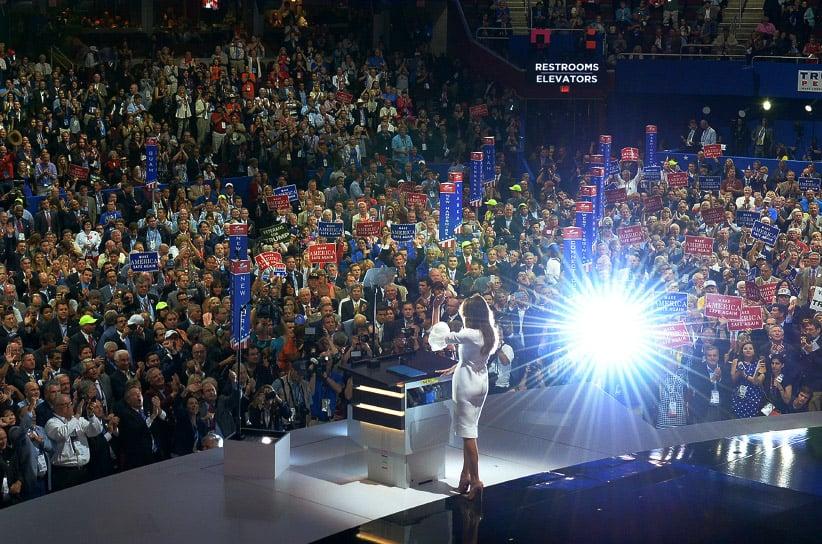
Melania Trump waves to the crowd on the opening day of the Republican National Convention. (Toni L. Sandys/Getty Images)
Pundits had predicted riots on the streets of Cleveland during the Republican National Convention, but all the chaos was confined to the stage at the Quicken Loans Arena. Trump had promised four nights of “showbiz,” which was accurate if he was thinking of The Texas Chainsaw Massacre. Party heavyweights like ex-president George W. Bush and 2008 and 2012 nominees John McCain and Mitt Romney stayed away, and the biggest “celebrity” in attendance ended up being Scott Baio, the banjo-eyed star of long-ago sitcoms like Charles in Charge and Joanie Loves Chachi. Trump’s wife, Melania, opened the festivities on July 18 with a well-received speech—at least until a sleuth noted that she had lifted several passages, word-for-word, from Michelle Obama’s 2008 address to the Democrats. The billionaire’s own self-aggrandizing appearances—a smoke and lights entrance worthy of pro wrestling on the first night, and a spotlight-hogging introduction of Mike Pence, his vice-presidential pick, on night three—failed to silence his critics. But it was Trump’s acceptance speech, a 75-minute litany of all that was wrong with America, that really creeped people out.
“I have a message to every last person threatening the peace on our streets and the safety of our police: When I take the oath of office next year, I will restore law and order to our country,” he hollered, dwarfed by a backdrop of his own image projected on a giant screen. “In this race for the White House, I am the law and order candidate.”
Still, Trump’s official confirmation as Republican standard-bearer provided a solid bounce in the polls that was aided, undoubtedly, by the emergence of 20,000 hacked internal Democratic Party emails on WikiLeaks.org, detailing the establishment’s preference, and sometimes active rule-bending, for Clinton over Sanders. (U.S. intelligence agencies said they believed that the Russians were behind the data breach.)
On July 25, the day the Democratic convention opened in Philadelphia, Trump took a slim lead over Clinton in the polling averages. As pro-Sanders delegates staged noisy walkouts and geeky acts of protest—like the woman dressed as Princess Leia holding a sign that read “Bernie Wan Kenobi is our only hope!”—Trump’s advantage grew to more than a percentage point. Until the final night, when Khizr Khan and his wife, Ghazala, addressed the floor. It took the grieving parents of Humayun, a 27-year-old Muslim-American soldier killed in Iraq in 2004, just six minutes to lay the Republican nominee low. “He vows to build wall and ban us from this country. Donald Trump, you’re asking Americans to trust you with their future. Let me ask you, have you even read the United States Constitution?” asked Khizr, pulling a pocket-copy from his suit jacket. “You have sacrificed nothing! And no one.”
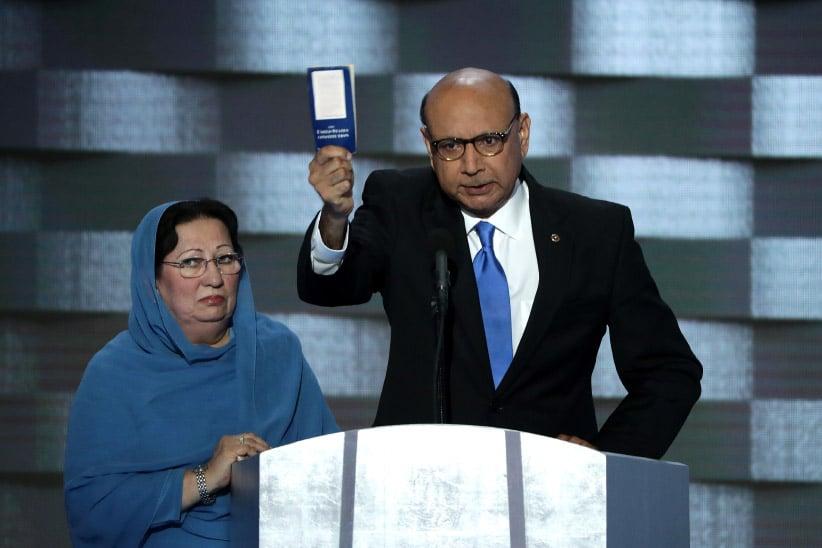
Khizr Khan holds up a booklet of the U.S. Constitution. (Alex Wong/Getty Images)
If the events of July had reminded voters why they didn’t really trust Hillary Clinton, the beginning of August solidified why they really didn’t like Donald Trump. The Republican spent days peevishly attacking the Khans, first suggesting that the hijab-wearing Ghazala hadn’t spoken because “she wasn’t allowed to have anything to say.” Then he boasted of his own “sacrifices,” noting he employed thousands of people. “I work very, very hard.”
As the backlash grew and Trump’s statements about the Khan family were rejected by senior Republicans like John McCain and Paul Ryan, the Speaker of the House, the nominee started lashing out at his own party as well. Then, perhaps in some sort of misguided effort the change the channel, Trump decided that he had a few things to say about Clinton’s handling of classified information. “Russia, if you’re listening, I hope you’re able to find the 30,000 emails that are missing,” he announced at a Florida press conference. “If Russia, or China or any other country has those emails, I mean, to be honest with you, I’d love to see them.”
Publicly inviting hostile foreign governments to steal U.S. secrets may not qualify as outright treason, but it’s hard to reconcile with an “America First” foreign policy. By the second week of August, Clinton had once again opened up an eight-point lead in the polls. Increasingly, though, it seemed like the American electorate were just underwhelmed by the available choices. Asked if the Democratic nominee was “honest and trustworthy,” 61 per cent of respondents to a Fox News survey said “not.” When posed the same question about Trump, the figure rose to 62 per cent.
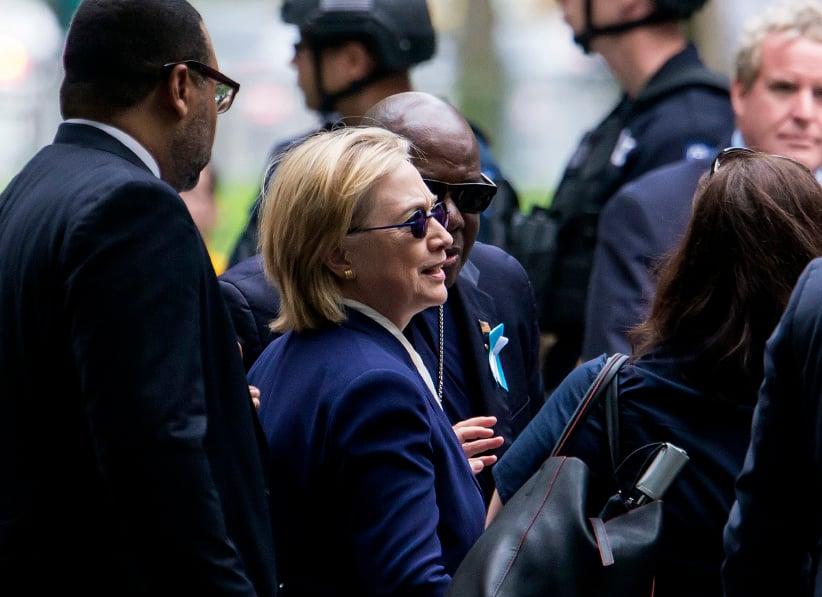
Clinton attends a ceremony to mark the 15th anniversary of the 9/11 attacks in lower Manhattan. (Eric Thayer/The New York Times/Redux)
Chapter 7
Sept. 9, 2016: It’s all rigged!
First Hillary Clinton stumbled, then she collapsed. The remarks were awfully blunt for a woman who had been pitching herself as some sort of conciliator-in-chief for a divided nation. “You know, to just be grossly generalistic, you could put half of Trump’s supporters into what I call the ‘basket of deplorables,’” the Democratic nominee told a friendly audience at a LGBT-community fundraiser in New York City. “The racist, sexist, homophobic, xenophobic, Islamophobic—you name it. Unfortunately, there are people like that, and he has lifted them up.”
The backlash was swift, or maybe even Swiftian. Trump himself took to Twitter to label Clinton’s comments “so insulting,” while his campaign surrogates filled cable news channels with canned outrage and demands for an apology. But many of his biggest fans seemed more tickled than offended, scooping up hats and T-shirts that proclaimed “Deplorable Lives Matter,” and “Adorable Deplorable for Trump-Pence 2016.”
Clinton issued a statement the next morning, saying she regretted her choice of fractions, but didn’t sound very sorry, hammering her Republican opponent once more for cozying up to the “alt-right” and white supremacists. Then she made matters worse by suddenly appearing human.
On the 15th anniversary of the 9/11 attacks, the 68-year-old cut short an appearance at a sunny, Ground Zero memorial service, claiming she had become overheated. Within minutes, however, a cellphone video circulated in which she appeared to swoon as Secret Service agents helped her to her van. Later in the day, her campaign issued a curt statement admitting that Clinton had been suffering from pneumonia, and would take some time off the trail to recover.
Trump had been seeding doubts about her health for months. “To defeat crime and radical Islamic terrorism in our country, to win trade in our country, you need tremendous physical and mental strength and stamina. Hillary Clinton doesn’t have that strength and stamina,” he told a Wisconsin crowd in August. Sympathetic media outlets like Fox News and Breitbart had gone much further, pushing stories that she had been having secret seizures and was wearing a portable defibrillator underneath her jacket, all part of an attempt to cover up some serious medical problems. Now they had video “proof” of their dark suspicions.
By mid-September, Clinton’s lead in the national polling averages had again shrunk to a single percentage point—a stunning turnaround for Trump, who had been almost 10 points behind when he fired his latest campaign manager Aug. 18. More tellingly, the opinion surveys suggested his tactics were working, with just 36 per cent of respondents to an Associated Press poll agreeing that the Democratic nominee was “healthy enough” to become president. Never mind that Clinton was the one who had actually released relatively detailed medical records, while Trump had simply furnished the press with a note from his gastroenterologist attesting that the 70-year-old “will be the healthiest individual ever elected to the presidency.”
The billionaire was devoting an ever-increasing amount of his time to the peddling of conspiracy theories. Trump had always been a proponent of fact-free beliefs, like the supposed link between childhood vaccines and autism, or climate change being a Chinese-backed “hoax.” But the campaign trail was proving to be an irresistible forum to talk about all the things that “some people say”—from the “suspicious” death of right-wing Supreme Court Justice Antonin Scalia, to allegations that Ted Cruz’s father had links to John F. Kennedy’s assassin, to the “great Trojan horse” threat posed by Syrian refugees. One website dedicated to debunking his bizarro claims counted 58 of them before finally giving up in late May.
Trump’s grand legacy to American politics may end up being the mainstreaming of ideas that were previously confined to obscure chat rooms and fringe websites. “Stories that no one in the media would normally touch have ended up being covered because the Republican nominee talked about them,” says Tom Nichols, a national security expert at Harvard and the U.S. Naval War College, and author of the forthcoming book The Death of Expertise. “Trump probably doesn’t believe half of the things he says. He’s doing it to generate buzz. But the problem is that some people aren’t educated or savvy enough to know when they are being played.”
Democrats have their own problems with believers in dark, outside forces, Nichols notes. (Back in 1998, Hillary Clinton famously suggested a “vast right-wing conspiracy” was driving the investigation of her husband Bill’s affair with Monica Lewinsky.) But Trump has continually redrawn what were previously considered to be the boundaries of decency. And the billionaire’s claims later in the campaign that the general election was being “rigged” against him might be his most dangerous yet, says Nichols. “When these concepts are validated by a respected source, people buy into the illusion that their tiny, minority viewpoint in now shared by a majority. And that can fuel some real resentment when their issue doesn’t get traction.”
Clinton’s health recovered, but the initial secrecy surrounding her illness had a more lasting effect. As David Axelrod, one of the architects of Obama’s 2008 and 2012 victories, archly observed, it was a self-inflicted wound. “Antibiotics can take care of pneumonia,” he posted on Twitter. “What’s the cure for an unhealthy penchant for privacy that repeatedly causes unnecessary problems?”
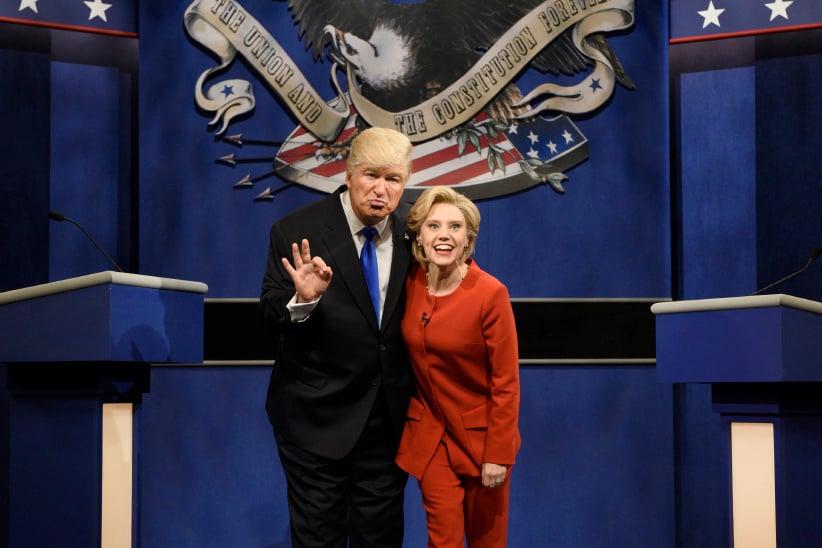
On NBC’s Saturday Night Live, Alec Baldwin appears as Trump and Kate McKinnon as Clinton. (Will Heath/NBC/Getty Images)
Chapter 8
Sept. 26, 2016: The winning temperament
Donald Trump lost the first debate, and much of the country, with four little words: “That makes me smart.”
It had already been a tough night for the Republican nominee. Suffering from a cold, or some sort of allergy, he sniffed audibly and often as he stood on the stage at Long Island’s Hofstra University. Hillary Clinton was clearly succeeding in getting under his skin.
The billionaire, whose staff are always careful to refer to him only as “Mr. Trump,” bristled at her repeated use of his first name. “Secretary Clinton—yes, is that OK?” he asked early on. “Good. I want you to be very happy. It’s very important to me.” He couldn’t stop himself from interrupting her answers with denials and snide asides. “I did not. I did not. I did not say that,” Trump protested when she brought up his rejection of climate change. “Wrong. Wrong. Wrong,” he said when she mentioned his support for the Iraq war. “That’s called business, by the way,” was his response to Clinton’s claim that as a real estate speculator he had “rooted” for the 2008 housing crisis. And then there was his simple, “Ugh,” when she lamented his “dire” and “negative” descriptions of life in America’s black communities.
The defining moment, however, came 35 minutes into the 90-minute affair, when Clinton was hammering Trump on his refusal to follow tradition and make his tax returns public. The Democrat put forward some theories about what he might be trying to hide—that he wasn’t as rich or charitable or solvent as he claimed. Then she flat out accused the man who likes to brag about his $9 billion net worth of not paying any federal tax at all. Trump shook his head and grimaced like a Muppet—then he just copped to the charge.
A TV audience of 84 million—a new record for a presidential debate—had tuned in to catch the first clash between Clinton and Trump. Tens of millions more were following live streams. Now they had an admission that the man who liked to complain about the unfairness of a “rigged” system was among its worst manipulators. It felt like a turning point. A Washington Post journalist, who was watching with a room full of undecided voters in North Carolina, reported that they gasped out loud at the four-word comeback.
Clinton wasn’t flawless. In the early going, Trump had her on the defensive over her support for NAFTA and other free-trade deals. But she displayed her mastery of a broad range of issues, delivered a few prepared zingers and kept her cool. More important, the contrast between Clinton’s steady, smiling performance, and Trump’s twitchy, angry one put paid to his repeated claims that she didn’t have the “look” of a president. By the end of the night, the debate-hall audience was openly mocking the former reality-TV star’s own Oval Office pretensions. “I think my strongest asset, maybe by far, is my temperament,” Trump said to general groans and laughter. “I have a winning temperament. I know how to win. She does not.”
The post-debate polls confirmed what most observers had concluded before the set-to even ended—it was a clear-cut victory for the Democratic nominee. CNN viewers gave the night to Clinton, 62 to 27 per cent. Reuters/IPSOS respondents scored it 56 to 26. An ABC News/Washington Post poll found 53 per cent believed Clinton had won, versus 18 per cent for Trump. The real estate mogul was reduced to complaining about the moderator’s questions and blaming his nasal wheeze on a “defective” microphone. The next weekend, Saturday Night Live opened its season with the actor Alec Baldwin playing an entirely out-of-his-depth Trump, ranting, railing and mispronouncing China. The ratings easily eclipsed the Republican’s own turn as host the year before.
With a little more than a month to go before the vote, the U.S. public finally seemed to be wrapping their heads around their choices. Both candidates remained historically unpopular, but one at least appeared suited to the job she so desperately wanted.
For all the talk about the “look” and qualities that Americans demand of the occupant of 1600 Pennsylvania Ave., the 44 holders of the office of president to date haven’t had much in common—beyond their sex. “We know that as a group, presidents tend to be more extroverted and open to experiences than average Americans. But the range of variance [in their traits] is larger than in the general population,” says Steve Rubenzer, a forensic psychologist from Texas who has studied the personalities of past commander-in-chiefs. A 2013 paper he co-authored, published in the journal Psychological Science, ranked 42 presidents by their “grandiose narcissism.” Lyndon Johnson was judged to be the most self-infatuated, followed by Teddy Roosevelt and Andrew Jackson, then FDR and John F. Kennedy. Bill Clinton came seventh.
Rubenzer says the team also looked at Hillary Clinton’s personality and figured she was roughly equal to the sixth-place Richard Nixon. “She’s somebody who is kind of on the disagreeable end of things. She scored pretty low for warmth,” he says. Neither Rubenzer nor his colleagues have assessed Trump, although he suspects the Republican’s unpleasant demeanour and willingness to make “non-factual” claims, might place him even higher on the self-absorbed scale.
After 15 months of non-stop campaigning, the U.S elections was going down to the wire on a single, ballot-box question. Who was the lesser of evils?
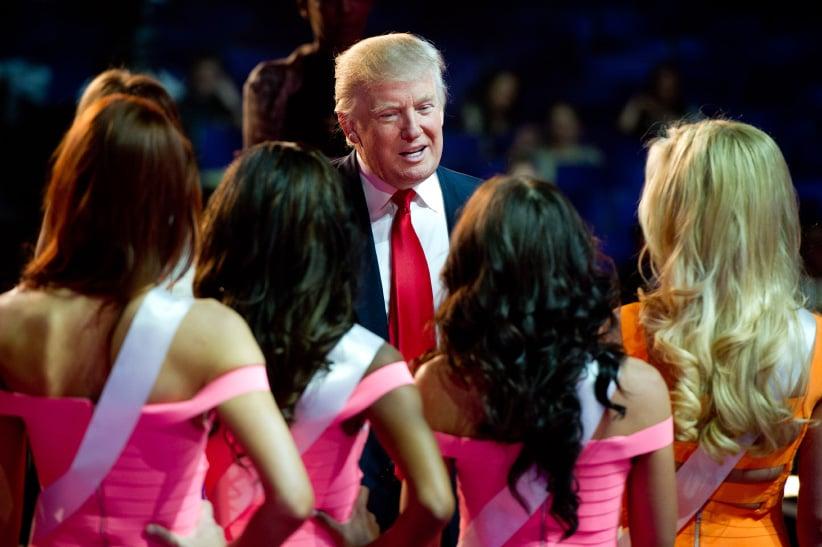
Trump speaks with the 2013 MISS USA Delegates. (Darren Decker/Miss Universe Organization/AFP)
Chapter 9
Oct. 17, 2016: ‘The Great Gropesby’
Prior to that Friday afternoon, Billy Bush’s greatest contribution to history was bumping into U.S. swimmer Ryan Lochte on the beach in Rio. The 45-year-old co-host of NBC’s Today Show had the presence of mind to pull out his iPhone, press record, and ask a few questions about a rumour circulating on social media—that the 12-time Olympic medallist and some teammates had been victims of a robbery after a night out on the town.
As it turns out, Bush—a minor cousin to the presidential dynasty—had the inside scoop on an even bigger scandal, although he might well have been too clueless to know it. Back in 2005, when he was still cutting his perfectly veneered teeth at Access Hollywood, a daily entertainment digest, Bush had spent an afternoon trailing Donald Trump around as the reality-TV star made a cameo appearance on the soap opera Days of Our Lives. And engaging in some awfully frank off-camera conversation.
The tape, which had been locked away in the show’s archives for more than a decade, captured Trump and Bush chatting about a woman as they waited for their cue. “I did try and f–k her. She was married,” admits the billionaire, who had recently wed his third wife, Melania. There’s a complaint about a boob job, then the pair notice actress Arianne Zucker, who is waiting to greet them. “I better use some Tic Tacs, just in case I start kissing her,” Trump says. “I just start kissing them. It’s like a magnet. Just kiss. I don’t even wait. And when you’re a star, they let you do it. You can do anything.”
“Whatever you want,” Bush chimes in.
“Grab ’em by the p—y,” Trump responds. “You can do anything.”
It was the Washington Post that first published a leaked copy of the exchange—although NBCUniversal, which employed Bush, owned Access Hollywood and broadcast Trump’s The Apprentice for 14 seasons, had been sitting on their own story for at least a week. Later that night, Trump posted a video to his Facebook page. “I’ve never said I’m a perfect person, nor pretended to be someone that I’m not,” he said. “Anyone who knows me knows these words don’t reflect who I am. I said it, I was wrong and I apologize.” It appeared that the Republican nominee might be legitimately sorry—until he got to the part where he accused former president Bill Clinton of abusing women, and Hillary Clinton of aggressively covering up for her husband.
By the start of the second presidential debate, that Sunday evening, Trump had dropped all pretense of shame. Three women who alleged that Bill Clinton had sexually attacked or harassed them in the past were Trump’s invited guests. His campaign managers hoped to engineer an on-camera confrontation between the former commander-in-chief and his accusers, but were stopped by organizers. When Trump took the stage, he brushed off his own boasts about sexual assault as purely “locker room talk.” Then he tried, unsuccessfully, to change the subject to the fight against ISIS.
Trump’s sexist attitudes about women, and his sometimes questionable actions toward them, were hardly unknown. This was a man who publicly carried on affairs, boasted about his conquests, critiqued women for their looks and expressed a deeply creepy admiration for the body of his daughter Ivanka. But women were now coming forward to share stories about how an already rich man, who now aspired to the most powerful job in the world, had kissed, grabbed and fondled them, just like he bragged about on the tape. By Oct. 20, there were 10 accusers in total, and the Daily Show had saddled Trump with a new nickname: “The Great Gropesby.”
Republicans who had stood by a nominee who advocated war crimes, cozied up to Vladimir Putin and mused about banishing an entire religion from the country, who stood by him through revelations about his bogus charity, sketchy tax returns and constant lies and distortions, suddenly discovered their conscience. Senators John McCain and Kelly Ayotte withdrew their endorsements. Paul Ryan, the Speaker of the House, said he would no longer campaign alongside him. But Trump’s plummeting poll numbers only seemed to make the billionaire more defiant. On the hustings, blistering attacks against his accusers became the heart of his stump speech. He even joked about the allegations, suggesting some of the women weren’t attractive enough to merit his attention.
As with so many things about Trump’s campaign, the strategy made no sense. Women make up 51 per cent of the U.S. electorate and are its most important demographic, voting in greater numbers than men. A Republican hasn’t won the women’s vote since George H.W. Bush in 1988. Ten major national polls taken in October showed Clinton with a 13 percentage point lead among female voters, on average.
In the first presidential contest with a woman as a majority-party nominee, gender was destined to be an issue. But it didn’t play out the way the experts predicted. Kelly Dittmar, a scholar with the non-partisan Center for American Women and Politics at Rutgers University in New Jersey, says Clinton played the card far differently this year than she did in 2008. “Back then, her strategists were very concerned that the country wasn’t ready for a ‘first mama,’ but they thought it might accept a ‘first father’ who happened to be a woman,” says Ditmar. This time, Clinton’s gender was a selling point. “There’s a willingness to say that as a woman she brings something distinct and different, a value added to the office.”
Trump, on the other hand, chose to go full caveman. “He’s really played into the most traditional stereotypes. The most toxic, misogynistic version of masculinity,” says Dittmar.
In early August, the Republican nominee went on Fox and tried to explain why he was actually doing better with women than the pundits claimed—because only he can protect them. “They were saying: ‘We like Donald Trump because we feel he’s going to be the strongest for the country in terms of protection, in terms of the border, in terms of ISIS, in terms of other countries,’” he said.
The joke writes itself.
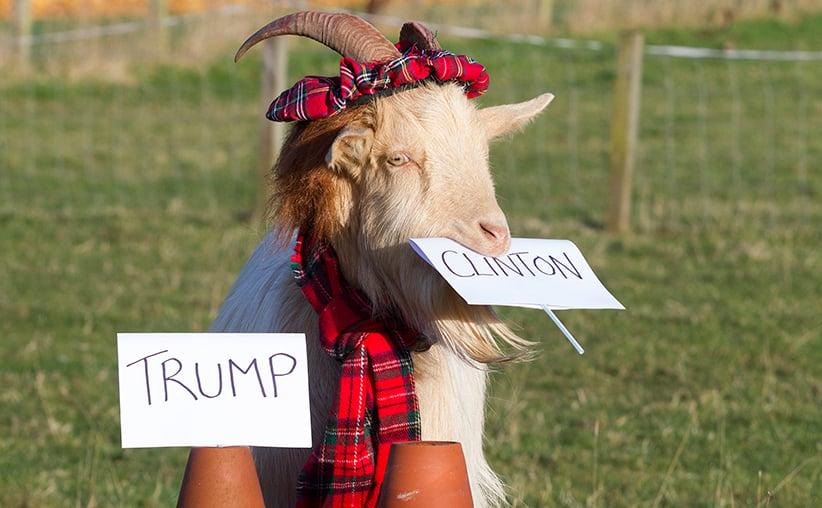
Boots the psychic goat predicts the results of the election. Boots picked Clinton. (Katielee Arrowsmith/SWNS)
Chapter 10
Oct. 28, 2016: One last surprise
The 16-year-old North Carolina girl learned about the letter when reporters started calling. It was late on Friday afternoon, the same day she had spent seven hours being interviewed by FBI agents, yet there had been no warning or explanation. If James Comey’s decision to reopen the investigation into Hillary Clinton’s use of a private email server came as a surprise to the Democratic nominee, it was an even bigger shock for the girl who, in September, spoke to Britain’s Daily Mail, alleging that Anthony Weiner, a 52-year-old former Democratic Congressman who was married to one of Clinton’s top aides, had been sending her sexually explicit texts. Now, Comey’s letter to House and Senate leaders had placed the teenager at the centre of a vicious partisan battle just as the election campaign entered its final stretch.
“I thought your job as FBI director was to protect me. I thought if I co-operated with your investigation, my identity as a minor would be kept secret,” the girl, who was 15 at the time of the alleged incidents, wrote in a open letter to America’s top cop a few days later. “My family and I are barraged by reporters’ phone calls and emails. I have been even been blamed in a newspaper for causing Donald Trump to now be leading in some polls and costing Hillary the election.” In an interview with Buzzfeed, the unnamed teen said it was all the worse because she and her family were “big fans” of Clinton. And that if Trump indeed won, she planned to move to Germany.
The FBI director’s statement only said that the emails found on a laptop belonging to Weiner and his estranged wife, Huma Abedin, “appear to be relevant” to the probe over Clinton’s handling of classified information that he had declared closed in July. But that was enough to reinvigorate Trump’s stumbling bid for the White House. “This is bigger than Watergate,” he told an Iowa rally the night the story broke. “Hillary Clinton is the most corrupt person ever to seek the office of the president of the United States,” he crowed a couple of days later in North Carolina. Three months earlier, Trump had accused Comey of being part of a “rigged system.” Now he praised the FBI head for doing the “right thing” and salvaging the bureau’s reputation. “It took a lot of guts.”
Trump had continued to bang on about “Crooked Hillary” and her emails all through the summer and fall. And to a large measure, he helped ensure that, scandal or not, the controversy defined her campaign. When Gallup asked voters what they had heard about Clinton in weekly surveys over that period, “email” was the No. 1 answer eight times out of 10. (The Democratic convention topped the list once in July, and her health troubles once in September.) The reopening of the investigation was manna from heaven for the Republicans. Clinton’s lead in the national polling averages shrank from five points to one in a single week. As the state surveys tightened too, Trump’s long-obscured path to the 270 electoral college votes needed to win the presidency reappeared.
Trump’s campaign managers banned him from Twitter. For once, the billionaire stuck to the script—even if he occasionally read the stage directions aloud. “We’re going to be nice and cool, nice and cool, stay on point, Donald, stay on point,” he told a Florida crowd. Although not everyone internalized the directive. Rudy Giuliani, one of his principal campaign “surrogates” (the single worst buzzword of the 2016 campaign) went on TV and let the world know that Trump-friendly FBI agents had been feeding him inside information about the Clinton probe. Ted Nugent, who had a music career back in the ’70s, appeared on stage at a rally in Michigan and tried to get out the vote by grabbing his own crotch. “I’ve got your blue states right here, baby,” he shouted, bewilderingly.
It took nine days for the FBI to again determine that Clinton had done nothing wrong. Agents worked around the clock to review all the emails pertaining to her time as secretary of state, Comey wrote in a second letter to Congress, dated Nov. 6, but found nothing new. “Based on our review, we have not changed our conclusions that we expressed in July.”
The Democrats rejoiced. Just as predictably, Trump and the Republicans railed at the perceived injustice. The real question was whether the late October surprise and the see-sawing opinion polls had actually altered how anyone was going to cast their ballot. In hyper-partisan America, fewer and fewer voters are inclined to cross between the two major camps. Only five per cent of people surveyed at the beginning of November still claimed to be undecided.
The most significant change in the 2016 electorate may be the mass migration of white, “low-information” voters to Trump. A research study released two days before the election declared that he had attracted a “disproportionate and unprecedented” number of the intellectually imprecise to his cause. “There’s a block of voters out there who don’t spend a lot of time doing research on the issues and don’t want to,” explains Richard Fording, a professor at the University of Alabama who co-authored the paper with City University of New York political scientist Sanford Schram.
Low-information voters—categorized via a survey in which they agreed with statements like “thinking is not my idea of fun,” and were unable to answer basic U.S. civics questions like the length of a term in the Senate—split fairly evenly between Barack Obama and Mitt Romney in 2012. This time around, however, people with less “need of cognition” and little knowledge of government are significantly more inclined to support Trump over Clinton. According to the research, their affinity for the populist Republican is most often based on “racial and ethnic anxieties,” with the myth that Obama is a Muslim being their top shared belief. “What has also attracted them are Trump’s themes and messages stressing racial hostility toward immigrants, particularly Muslims,” says Fording. “They have no interest in looking at facts.”
When Trump appeared to be closing the gap in the polls, the stock market dropped for nine straight days, Wall Street’s lengthiest losing skid in more than three decades.
Conversely, news of Clinton’s renewed exoneration by the FBI sparked a rally, goosing the Dow Jones average by 371 points, the biggest one-day jump since March. Meanwhile in Scotland, Boots, the tartan-tam-wearing psychic goat who correctly forecasted a Brexit vote last spring, chose to nibble on a Clinton sign, rather than a Trump one, a sure portent of a Democratic Party victory. All but one of the national polls over the final days, showed Clinton in the lead.
The craziest, most divisive election in U.S. history seemed to be coming to a predictable end—except for one puzzling bit of news out of New York. A fireworks display over the Hudson River, planned as part of Clinton’s victory celebration, had been quietly cancelled by her campaign. Without an explanation.
CORRECTION, Nov. 11, 2016: A previous version of this story claimed Mitt Romney was a former governor of Utah. In fact, Romney is former governor of Massachusetts.
Reporter: Jonathon Gatehouse
Editor: Colin Campbell
Art director: Stephen Gregory
Director of Photography: Liz Sullivan
Assistant editor, digital: Nick Taylor-Vaisey
Published: November 9, 2016